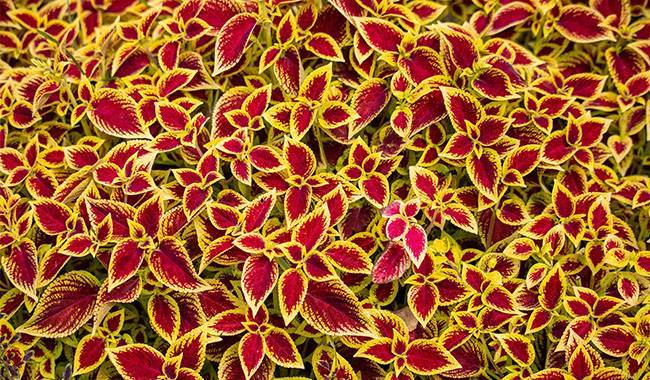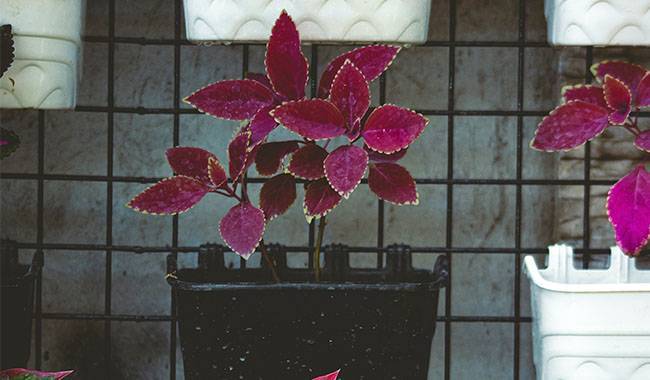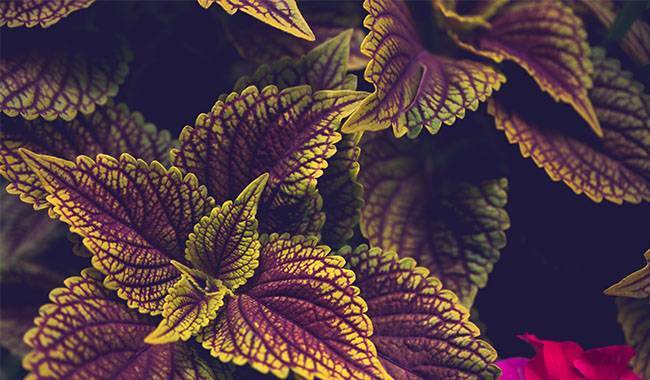
The luxurious patterns and color combinations on Coleus foliage are a memorable sight to behold. But unfortunately, the bright show doesn’t last indefinitely. As long as there is enough light, Coleus is fine. However, as fall approaches, they inevitably lose their appeal, becoming misshapen and wilting. If they are used as decoration in the garden or on the balcony, they will die with the arrival of cold weather. To maintain and renew the value of your collection, you need to save the shrubs you grow coleus until spring. And it is not difficult to do this because the plants can compromise on temperature and light.
A DIFFERENT GOAL – THE SAME RULES FOR OVERWINTERING COLEUS
Lovers of fresh-leaf Coleus have long noted that age is not a good thing. Lush, bright bushes look like miserable branches with leaves only at the top in the second year. Under ideal conditions, Coleus can still “deform” without serious care errors. If can inhibit active growth by stimulating thickening, then loss of the oldest, lower leaves and the baldness of the “lower” bushes is inevitable as they age. Any Coleus plant will still have to be renewed and rejuvenated.
Each year, in each rejuvenation case, the Coleus plant will still wilt and be less effective than younger and stronger shrubs. This is why many people make the Coleus plant a must-buy every year. And, unfortunately, more and more growers are simply discarding these plants, preferring to buy ready-made seedlings or grow new varieties from seed. It’s a shame to see Coleus plants in junkyards-they’re easier to propagate from cuttings and won’t reach their full potential in one season.
So that you can keep your favorite cultivar year after year, you can
- Give it a good overwintering environment so that it can be enjoyed on your windowsill in winter as much as it is in summer.
- Do the bare minimum to keep the shrub alive until spring with a thorough revival, a spring pruning, after which it will grow back into lush shoots.
- Save the shrub with minimal care for spring cuttings that will grow young to replace or supplement the older ones.
For some reason, overwintering Coleus plants (as perennials and propagating parent shrubs) is often seen as a problem. But in fact, there is nothing complicated about caring for Coleus plants in winter. Cooler temperatures, better lighting, and minimal watering are all the shrubs need to survive until the long-awaited spring.
THE IDEAL CONDITIONS FOR GROWING COLEUS IN WINTER
The coleus plant is not destined to disappear before your eyes in winter. It can still grow, display its bright foliage, and remain compact. But the key to maintaining its ornamental qualities is maximum light.
Even during active vegetative periods, the Coleus plant prefers to grow in as bright a light as possible, albeit diffused light, protected from direct sunlight.
Unlike summer, winter bushes do not need protection, and you should find a window in the house with the most light and place the Coleus plant in direct sunlight in the front row. Coleus plants will only benefit if it is possible to extend the daylight hours beyond 10 hours.
The coleus plant can tolerate frosts up to 23 °F (-5°C), but this does not mean that it will do well in a cold room. To care for Coleus plants indoors, you need to ensure a cool, not cold, overwintering environment that will allow the plant to maintain its strength until spring, compensate for the lack of light, and prevent the plant from deforming. The most important thing is to protect Coleus from high temperatures.
Even overwintering on a windowsill at 64-68 °F (18-20°C) and as close to the glass as possible is already a better option for the plant than the normal room temperature of the heating season. And, if you manage to bring the temperature down from 57-60 °F (14-16°C), you won’t have any problems keeping the bushes up at all. The combination of coolness and light can sometimes be problematic, but it’s still worth finding a place away from the hot cells.
HOW TO ADJUST THE CARE OF THE COLEUS PLANT IN WINTER?

Fertilization of Coleus plants should be stopped in mid-autumn. If the plant continues to grow and develop under ideal light conditions, the concentration and frequency of fertilizers can be reduced by two to three. However, fertilization is usually not done in winter.
Coleus plant needs to watering carefully. However, in winter, the water content should be reduced by watering more sparingly. Watering frequency should be controlled according to how quickly the substrate dries out to one-third. The amount of water should also be reduced, and over-watering should avoid. Getting stems and leaves wet in winter is a double danger.
In cooler temperatures, up to 60 °F (16°C), increasing humidity is dangerous. However, it should be controlled if the Coleus plant is kept warm in winter, especially at temperatures above 68 °F (20°C). 50-70% readings will help the City of Coleus survive the hot winter months.
WHAT SHOULD I DO IF I DON’T HAVE A SUITABLE LOCATION?
Often, our homes and apartments do not have the opportunity to provide a special overwintering environment for the plants, and room temperature is the only possible option. Suppose there is no opportunity to ensure that coleus has an optimal overwintering site that will allow it to remain beautiful and compact. In that case, you can immediately give up the dream of enjoying the foliage indoors in winter and accept the inevitable.
The main goal is to keep the plant alive until spring to rejuvenate or propagate. And this can be done, even if it is warm and not very bright.
- If it is possible to provide cool weather, but there is no chance to establish a bright regime, do not despair. Instead, find a shady place and adjust the watering to a minimum to keep the roots and buds healthy.
- Conversely, if there is a well-lit place, but in a warm room, everything will work out too. You need more frequent ventilation, higher air humidity, and more frequent watering.
Without the right location, both in terms of light and temperature, Coleus can remain until spring. The main thing is to accept that by taking care of the plant’s health, decorativeness will suffer. You need to correct watering at the right time, stop fertilizing and monitor plant signals to prevent the appearance of pests and diseases.
OVERWINTERING BALCONIES AND GARDENS COLEUS
Plants accustomed to daily changes and lots of fresh air can be overwintered in the same way as indoor plants. The main thing is not to move them suddenly and to give them time to adapt in the meantime, especially if Coleus are growing in open soil and are dug up and transferred to pots for the winter.
For caring for and propagating garden-type Coleus plants, the optimal temperature is a little lower, i.e. 50-53 °F (10-12 °C), but you can use the same temperature range as for indoor Coleus plants. Such Coleus will survive the winter if care is taken in due time.

THE END OF THE OVERWINTERING PERIOD
At the end of winter, the Coleus plant either takes cuttings or prepares for an active growing season. In the latter case, the plant can be replanted, and the topsoil can be renovated if there is still enough space in the pot. Most importantly, however, they should be pruned.
Severely damaged shrubs can be shortened, and old ones can be rejuvenated by cutting back to stumps. All post-overwintering operations for Coleus plants are gradual and include lighting, slowly acclimating the plant to brighter light, watering, and fertilizing, all of which should be done gradually.
BACK-UP PLAN – FALL AND WINTER CUTTINGS
Of course, like any other plant, it is best to take cuttings during the growing season. In spring and summer, cuttings root more easily and quickly, but in principle, it is one of the plants that can be cut all year round.
If extra light and cool housing are not available, or if Coleus plants are affected by radiators, or if rot is spreading when they are flooded – in short, if the bush is dying before your eyes, don’t wait until spring to do it. Don’t hesitate to cut a few stems and let them take root before the plants dead. Of course, you will have to wait longer to see the results. But you can also cultivate Coleus plants with winter cuttings.
During the cold season, grow the Coleus plant from cuttings, following the same rules as the rest of the year. Top cuttings of lightly woody shoots with one to three pairs of leaves, 4-6 inch (10-15 cm) long, are cut about 1 inch (2.5 cm) below the lower leaves, dried, and placed in a mixture of water, sand, perlite, and sand culture soil for Rooting. Light humidity, a stable temperature of about 64-68 °F (18-20°C), soft lighting. That’s all you need, except patience, of course.







